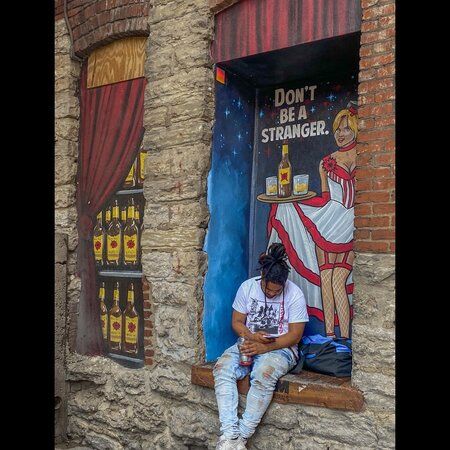
An Introduction to Printer’s Alley
Printer’s Alley, concealed between 3rd and 4th Avenues in downtown Nashville, Tennessee, is a historic street brimming with food, music, and the essence of a bygone era. This narrow and captivating alleyway, stretching from Union Street to Commerce Street, has been a staple of Nashville's entertainment scene since the early 20th century. From its origins as the hub of the city’s printing and publishing industry to its transformation into a legendary nightlife destination, Printer's Alley offers a glimpse into Nashville's rich cultural heritage.

Printer’s Alley: A Historic Hub of Printing
Printer’s Alley was created from a plot of land that was gifted to the city of Nashville in the 1780s by a former Virginia businessman, George Michael Deaderick.
The network of streets earned their name from Nashville’s connection to the numerous printing and publishing businesses that were first established in the area in the 1830s. By the mid-19th century the alley had become a bustling hub of printing presses, publishing houses, and two large newspaper offices — the Nashville Banner and The Tennessean.
The clatter of machines and the smell of ink filtered through the air, giving Printer's Alley a distinct atmosphere. As late as the 1960s there were more than 36 printing companies located in or around Printer’s Alley. While the printing industry has largely moved on, the legacy of its heyday remains imprinted in the Alley's character and in 2011 it was registered as a National Historic District.
Printer’s Alley: The ‘Men’s Quarter’
The Alley’s role as a printing hub attracted many restaurants, hotels, gambling halls, and clubs – especially those on the seedier side including the notorious Climax Club – to cater to the ‘needs’ of Nashville printing scene’s men. It soon became the vibrant heart of the city’s nightlife; attracting many politicians, judges, and lawyers, earning it the reputation as the ‘Men’s Quarter’ by the late 19th century.

When Prohibition came to Printer’s Alley
Due to its popular nature, the city’s politicians, including Nashville’s mayor and the police, protected the Alley, even after the Tennessee Prohibition Act was passed in 1909. This act banned the sale of alcohol but Printer’s Alley continued to play host to Nashville’s sordid consort of gambling, drinking, and sex. They would close their grand entrances and open up as speakeasies, accepting customers through the backdoors and, if questioned, claim that any alcohol had been brought in by customers (brown-bagged).

Repealing Prohibition
Nashville’s repeal of Prohibition in 1939 meant the sale of alcohol had been legalised but it was still not possible to purchase alcohol by the ‘drink’. This gave rise to a conglomeration of ‘mixer bars’ and clubs where customers could bring their own liquor to be mixed by bartenders at the venue.
Outside the Alley, illegal gambling began to filter into the bars and clubs. This fostered a sense of competition – it became necessary for Printer’s business owners to spice things up, to increase attraction.
In the late 1940s, king-pins like Jimmy Washer, James "Slow" Barnes, Bob Carny, and a youngster named David "Skull" Schulman found the perfect balance; fine dining, tasteful exhibitions of the flesh (burlesque shows), and live music, namely country and jazz. This gave rise to national performers such as Dixie Evans, Shannon Doah, even Russ Meyer starlet Kitten Natividad, who swirled through the Alley in a blur of sequins, flesh, and fringe.
Fine dining could be sought from The Captain's Table, The Brass Rail Stables and The Embers. Through the king-pins’ formula, the Alley prospered for the following 30 years.

A Post-Prohibition World in Printer’s Alley
In 1968, alcohol was fully legalised. It was the beginning of the Alley’s downfall. As suburban family life took priority throughout mainstream America, life in Printer’s Alley began to dry up. Tasteful burlesque shows were replaced with explicit strip clubs and gradually individual king-pins lost their grip on the place of sin and squalor they had ruled over since Prohibition began.
Today, Printer’s Alley remains a place of liquor and good food. In order to stay true to the Alley’s long-reigning history of secretive culture many of the restaurants are hidden away, some are in basements, and some still offer burlesque shows.
Murder in Printer’s Alley
By the late 1990s the Rainbow Room – an exotic dance club turned country bar in the 1990s – owned by Schullman, was the only venue linking Printer’s Alley to its heyday. Schullman was so notorious that the Nashville City Council named him ‘The Mayor of Printers Alley’. Despite his popularity however, he was attacked and murdered by two people in his club in 1998. The two individuals were caught but the Rainbow Room was closed, with many people claiming that Schullman’s spirit haunted the place and they could hear him calling out to them.
It wasn’t until June 2015, 20 years after Schullman’s tragic death, that The Rainbow Room finally reopened. With a capacity of 140, and an array of live music spread across that checkerboard stage – in place of burlesque performances – the restaurant-bar now exists as a tribute to the former owner, with two of his jackets framed and mounted on the wall.

The Birth of a Music Scene at Printer’s Alley
Printer’s Alley was home to more than just alcohol and as printing businesses began to dwindle a different kind of artistry took root. In the 1940s, the alley transformed into a thriving centre of live music and entertainment one honky-tonk, jazz club, and speakeasy at a time. Clubs such as The Black Poodle Lounge, The Rainbow Room and The VooDoo Lounge, provided a basis for artists like Chet Atkins, Waylon Jennings, Boots Randolph, and Dottie West to make their names.
By the 1970s, familiar household names like Paul McCartney and Jimi Hendrix were first establishing themselves on the Alley’s smaller stages. And so, Printer's Alley became a magnet for aspiring artists and a favourite haunt of locals and tourists seeking an unforgettable night out. In recent years, anyone from Tim McGraw to John Legend has made an honest start, or played a humble gig here within establishments like The Carousel Club, The Western Room and The Sundowner.

Printer’s Alley Today
Today, Printer's Alley retains its reputation as a premier nightlife destination in Nashville and the clubs that line the streets are direct descendants of the saloons and speakeasies that rocked the neighbourhood back in the day. Each venue offers a unique atmosphere and taste of Nashville's vibrant music scene. From blues and jazz to country and rock 'n' roll, the sounds of talented musicians fill the air, captivating visitors and keeping the spirit of Nashville’s live entertainment scene alive.
Stepping into the Past
Whilst the mood has changed a little over the years, tradition hasn’t and walking through Printer's Alley today, is like stepping back in time. The slick cobblestone streets, vintage signs, and neon lights invoke a sense of nostalgia and transport visitors to the days when the Alley was a thriving epicenter of creativity. History seeps from the walls of the establishments, and it's not uncommon to hear tales of legendary performances, secret tunnels, and the vibrant characters who once roamed these hallowed grounds.
Preserving Nashville's Legacy
Clearly the significance of Printer's Alley, as an important chapter in Nashville's history, has not gone unnoticed. Efforts have been made to preserve and revitalize this cultural landmark, ensuring its longevity for future generations. Restoration projects have breathed new life into the old Victorian buildings, preserving their architectural charm while accommodating the evolving needs of the city's nightlife.
Popular bars such as The Fleet Street Bar, Alley Taps, The Bourbon Street Blues & Boogie Bar, The Fiddle and Steel Guitar Bar, and Ms. Kelli’s – a thriving karaoke spot – uphold the Alley’s legacy of live entertainment. Skull’s Rainbow Room serves great food in addition to hosting burlesque performances. The Snitch in all its elegant glory offers a range of signature cocktails. And there is even space for one last ode to Printer’s seedy past with the baring of skin and sin at The Brass Stables strip club. As Nashville continues to grow and change, Printer's Alley remains a timeless link to the city’s past.

Our Thoughts…
Printer's Alley is a place where the soft echoing of printing presses have been replaced by the rhythm of live music and the vibrant pulse of a dynamic nightlife. Locals and tourists mingle, musicians share their talents, and stories are woven into the fabric of Nashville's cultural tapestry. Whether you're seeking a soulful performance, a night of dancing, or simply a taste of Nashville's iconic spirit, Printer's Alley is an unparalleled concoction of music, history, and culture.
Interested in finding more places like this? Try one of our CityDays Scavenger Hunts - untangle cryptic clues as a team as you discover the most unique, unusual and bizarre corners of Nashville and beyond.









